One of the most epic noodle dishes in the world from the streets of Malaysia: Char Kway Teow! Big flavours, contrasting textures and the signature hint of charred smokiness, this is bold South East Asian food at its best!

Char Kway Teow
I’ve shared many a recipes that I say are deceptively easy. From dumplings to quiches, with process photos and videos, even first-timers are able to follow along and are delighted to crown themselves Dumpling Queens, Wonton Kings, or Quiche Masters. (Self-proclaimed titles are fully encouraged around here!)
Char Kway Teow is probably the first recipe ever that I’m going to describe as deceptively difficult.
What may seem to be quite a straightforward stir fried noodle dish is actually a bit of an art that’s been perfected by Malaysian street hawkers, and it’s taken me this long to share the recipe because I wanted to ensure I could make it doable for anyone.
So today, I’m sharing the recipe two ways:
Base Recipe (experienced cooks): where everything is cooked at the same time in a wok or skillet, Hawker style; and
Easier Method: where ingredients are cooked individually then brought together at the end.
Use the Easier Method if you don’t have a strong stove, heavy based cast iron wok or very large heavy based skillet, if you are a newbie to the wok-cooking-world or if you simply prefer a more leisurely experience making this. Because this recipe moves fast once you hit the stove!
CKT thorns in my side!
When it comes to Char Kway Teow, I have two thorns in my side:
Noodle breakage – those wide, soft, slippery rice noodles are essential to a true Char Kway Teow experience. But they are notoriously delicate and prone to breaking when preparing and even worse, when cooking. I’ve covered this in the section below; and
The hint of charring – that aroma of smokiness from the wok – wok hei in Chinese, meaning “breath of the wok” – is part of the real Char Kway Teow experience. Unfortunately for us home cooks, our burners are simply no comparison to the fierce heat of Asian restaurant kitchens. So the charring is limited to a bit of caramelisation on the edges of the noodles, and on the Chinese sausage and fish cakes. This is something we must just accept. We can get close to the real deal – but not all the way. 😔 (And regular readers know it takes a lot for me to concede defeat)
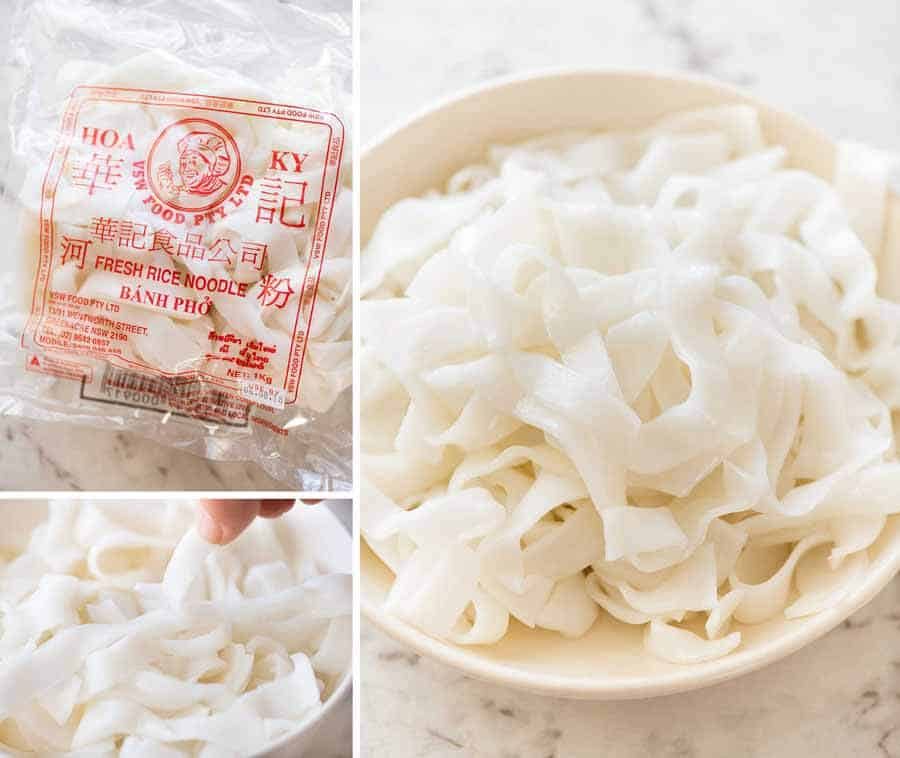
HOW TO PREPARE FRESH RICE NOODLES
Fresh, wide rice noodles are notoriously difficult to work with, prone to breaking when handled – even before they make it into the wok.
So it’s not a question of if the noodles will break – it’s how much they will break. Even Char Kway Teow at restaurants have broken noodles. So don’t expect to see a long noodle pull shot with Char Kway Teow – that photo above is the best I’ve ever been able to capture!
Here are my tips to minimise noodle breakage:
Fresh is best – Fresh noodles break less than dried. Really fresh noodles that have just been made and not even refrigerated break the least. I use refrigerated, packaged fresh rice noodles (I get mine from Harris Farm Markets and Asian stores);
Warm the noodles before portioning out the amount you need and separating the noodles which are stuck together. My chosen method: microwave. Alternative: run under warm tap water.
DO NOT boil or soak in boiling water or attempt to break apart fridge cold noodles. This = noodles breaking into a gazillion tiny pieces.
Minimise handling in wok. I know this goes against the very ethos of wok cooking, but the more they are handled, the more they break.
Toss or gently turn noodles in wok. You’ve always wanted to be a Wok Master and now’s your time to show off! Tossing is best to minimise noodle breakage, otherwise, use a spatula and a wooden spoon to gently turn the noodles in the wok (see video for technique).
Quick food nerd trivia moment:
* Gluten holds noodles/pasta together, and rice noodles have no gluten. Hence the breakage.
* Thinner noodles, like those used in Singapore Noodles and this Stir Fried Rice Noodles hold up much better to wild tossing in the wok.
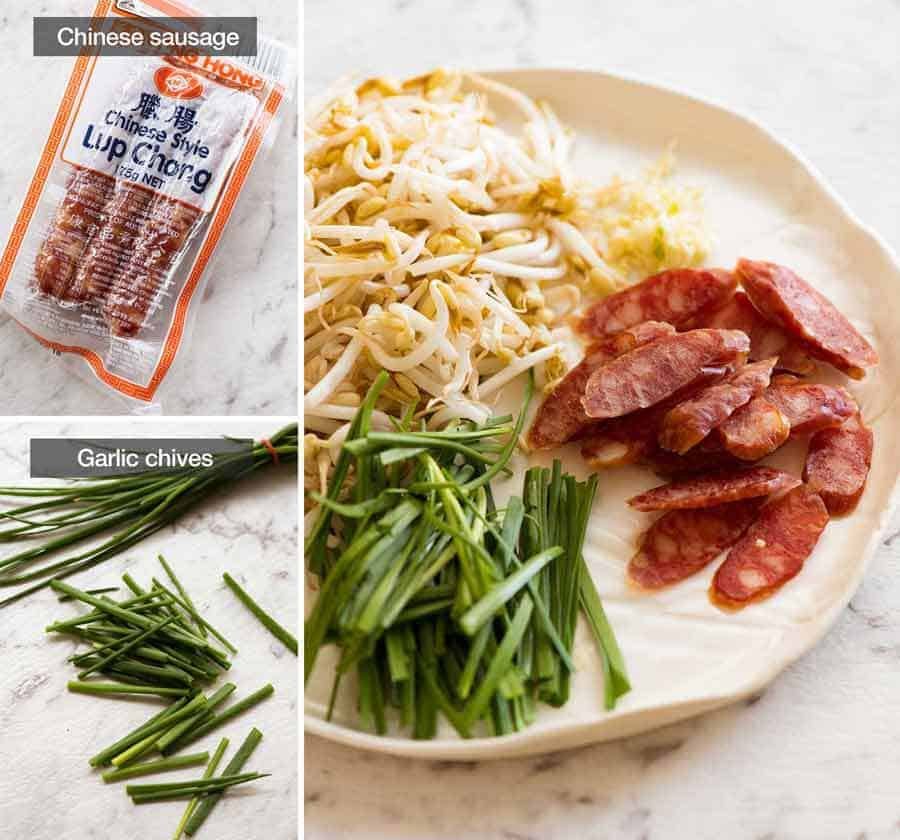
CHAR KWAY TEOW INGREDIENTS
There are a handful of signature ingredients in Char Kway Teow that will require a trip to the Asian store, and possibly showing the shop assistant the photos above to locate the items. It’s worth it, I promise! But actually, if you use my substitution suggestions, you can make this without a trip to an Asian store. 🙂
Chinese Sausage (Lup Chong) – Australia! This is sold at Coles and Woolies, can you believe that?? This is China’s answer to chorizo and bacon. It is salty and sweet, a very distinct flavour that is unlike anything else and it’s addictive. It’s sold in the Asian aisle (not fridge). You’ll only need 1 for this recipe so use the remainder in place of the Chinese BBQ Pork in Singapore Noodles, or for Fried Rice – it totally takes it to another level and puts the humble bacon to shame!!
Fried Fish Cakes / Pieces – It’s bouncy and it kind of tastes like seafood sticks, and it’s part of the Char Kway Teow experience. It’s sold in the fridge section of Asian stores. It can be substituted with other Asian Fish Balls that are sliceable (like this one from Coles or this one from Harris Farms). Toss leftovers into Chinese Noodle Soup or even Chinese Corn Soup!
Garlic Chives – they look like grass blades and taste like garlicky chives. If you can’t find them, it’s not the end of the world – just use normal chives or finely slice green onions on the diagonal. Or even leave it out.
The normal stuff – prawns/shrimp, egg, bean sprouts and garlic. Nice and easy to find!
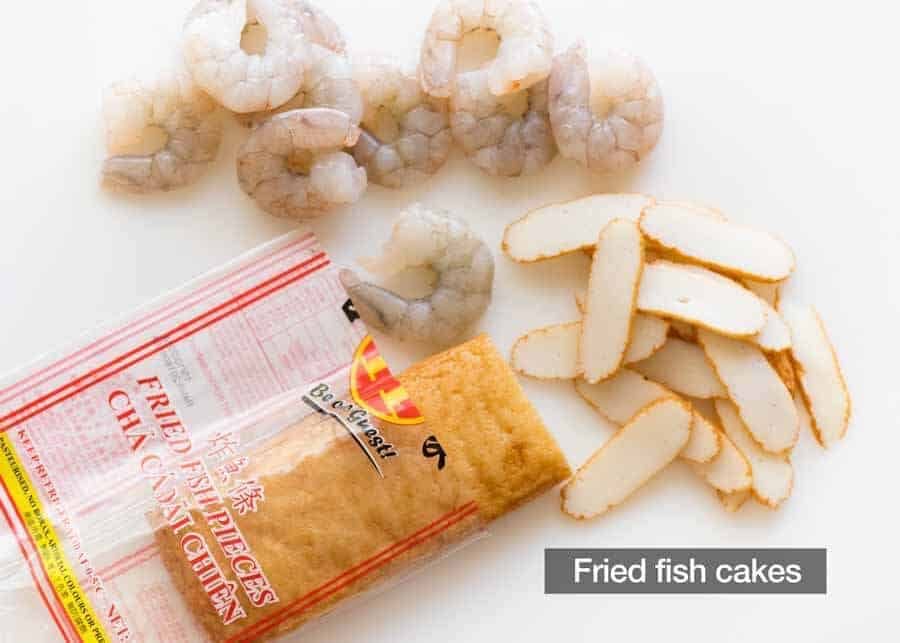
CHAR KWAY TEOW SAUCE
The sauce is pretty straight forward – dark and light soy sauce, Oyster Sauce and Kecap Manis, also known as sweet soy sauce. It has a consistency like maple syrup – see photo below.
You need both dark and light soy sauce because they play different roles in this recipe – the dark stains the noodles and adds flavour as well as saltiness to the sauce, whereas the light soy doesn’t stain the noodles, has less flavour but provides more saltiness.
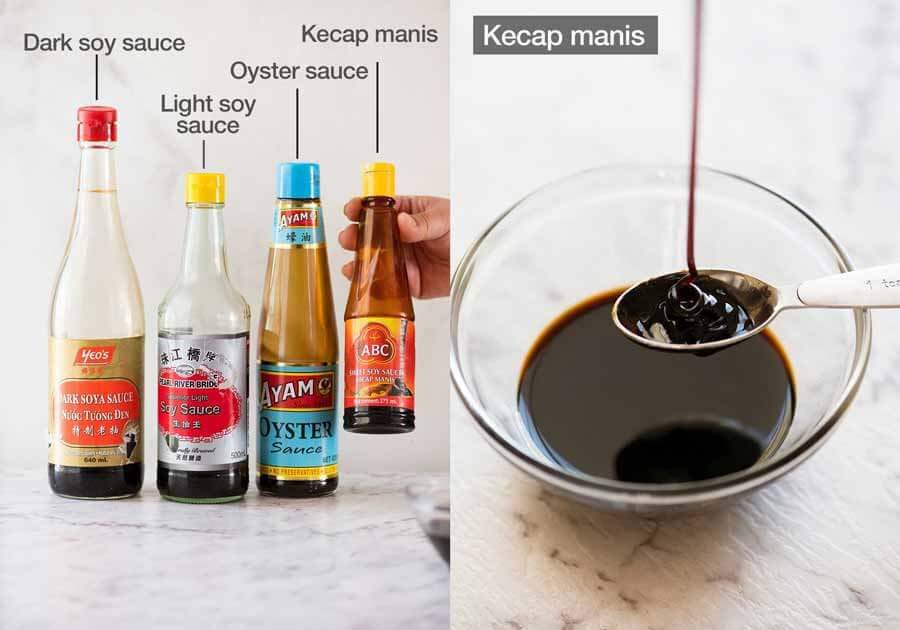
RECIPE SOURCES
This recipe is another RecipeTin Family effort. To craft our ideal home-style Char Kway Teow recipe, we firstly hit up some favourite Sydney Malaysian restaurants for “research”. Ho Jiak’s signature Char Kway Teow is one of our favourites, and was especially an inspiration.
As usual we also scoured YouTube to see the pros in action, watching video after video of food vendors on the streets of Malaysia tossing huge woks of Char Kway Teow to see how it’s done. (It was a double thumbs up if the dude was also shirtless and smoking a cigarette as he cooked.)
We even enlisted translation services for some of the videos so we could hear the chefs explain what makes a good Char Kway Teow!!
Classic Char Kway Teow usually includes blood cockles which we can’t easily find and personally find them less essential than the other ingredients so have left them out for our version.
We’ve eaten an inordinate amount of Char Kway Teow in recent weeks, creating this recipe. We know homestyle can’t be a perfect replica of street food, but we are darn happy with the results – and hope you love it too! – Nagi x
PS Ticking another off the Request a Recipe list!! And added to the DONE list (bottom of that post).
GREAT NOODLES FROM AROUND THE WORLD
- Chow Mein
- Pad Thai
- Pad See Ew (Thai Stir Fried noodles)
- Singapore Noodles
- Browse the Noodle recipes collection!
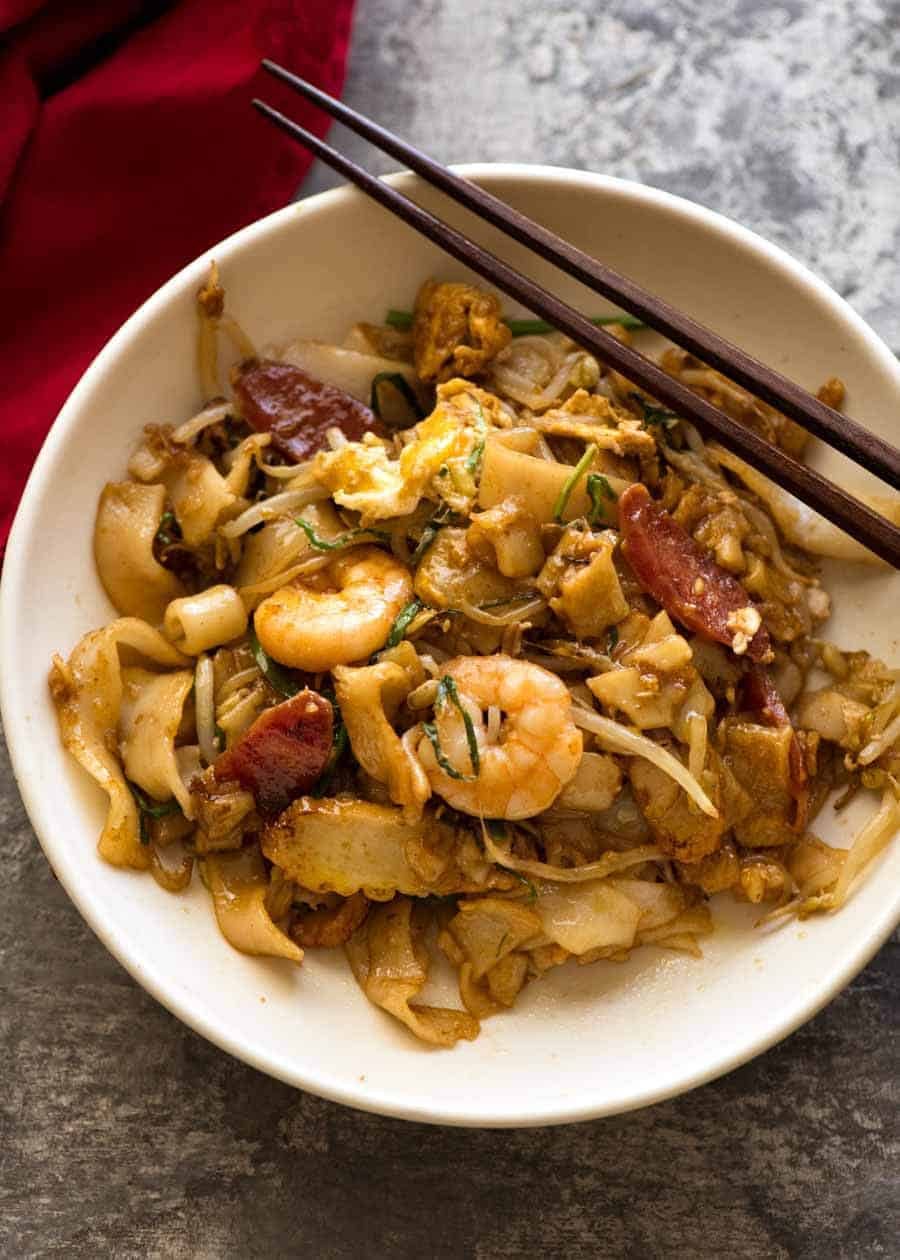
WATCH HOW TO MAKE IT
Hungry for more? Subscribe to my newsletter and follow along on Facebook, Pinterest and Instagram for all of the latest updates.

Char Kway Teow
Ingredients
- 500 g / 1 lb fresh wide rice noodle (Note 1)
- 2 tbsp lard , or vegetable oil (Note 2)
- 2 tbsp vegetable oil , separated
- 10 small prawns/shrimp , shelled and deveined
- 2 garlic cloves , finely chopped
- 1 Chinese sausage / Lup Chong Sausage , sliced thinly on the diagonal (Note 3)
- 5 cm / 2″ piece of fried fish cake , sliced thinly (Note 4)
- 20 stems garlic chives , cut into 4 pieces (Note 5)
- 2 1/2 cups bean sprouts
- 2 eggs , whisked
Sauce:
- 5 tsp dark soy sauce (Note 6)
- 4 tsp light soy (Note 6)
- 2 tsp oyster sauce (Note 6)
- 4 tsp kecap manis / sweet soy sauce (Note 6)
Instructions
- Mix Sauce together.
Noodles:
- Do not attempt to pull noodles apart while cold and hard – they break.
- Place whole packet in microwave, heat on high for 1 1/2 minutes – 2 minutes until warm and pliable, not hot, turning packet over as needed.
- Handle carefully and measure out 500g/1 lb noodles into a heatproof bowl. Separate noodles stuck together.
- If noodles become cold and brittle before cooking, cover with cling wrap and microwave for 30 seconds to make warm (not hot, just warm) to reduce breakage.
- Cook using Base Recipe (capable cooks) or Easier Method.
Cooking – BASE Recipe:
- Heat lard and 1 tbsp oil in a wok or very large heavy based skillet over high heat. Swirl around the wok.
- When it starts smoking, add prawns. Cook for 30 seconds.
- Add garlic, stir for 10 seconds.
- Add noodles, then using both hands on the handle, toss 4 times until coated with oil (or gently fold using a spatula + wooden spoon, see video).
- Add Chinese sausage and fish cake, toss or gently fold 4 times.
- Add bean sprouts and garlic chives, toss or gently fold 6 times.
- Push everything to one side, add remaining 1 tbsp oil. Add egg and cook, moving it around until mostly set – about 1 minute. Use wooden spoon to chop it up roughly.
- Pour Sauce over noodles, then toss to disperse Sauce through the noodles. Pause between tosses to give the noodles a chance to caramelise on the edges.
- Serve immediately!
Cooking – EASIER Method:
- Heat 1 tbsp oil in a large non stick skillet over high heat.
- When heated, add shrimp and cook for 1 1/2 minutes until just cooked through, then remove into bowl
- Add Chinese sausage and fish cake, and cook for 1 minute until sausage is caramelised, then add to bowl.
- Add 1 tbsp oil then add egg and cook, pushing in the edges to make a thick omelette. Once set, chop it up roughly using a wooden spoon (see video), then add to bowl.
- Add bean sprouts and cook for about 1 minute until just starting to wilt, then add to bowl.
- Add lard. Once melted and starting to smoke, add garlic then immediately add noodles. Fold gently 4 times using a spatula + wooden spoon (see video) just to disperse oil through noodles.
- Tip all the other ingredients back in plus the chives. Fold gently twice, then pour all the Sauce over.
- Gently toss 4 to 6 times to disperse the sauce, pausing in between to allow the noodles to have a chance to caramelise on the edges a bit.
- Remove from stove and serve immediately.
Recipe Notes:
** See Note 7 for suggestions for alternative add ins. 1. Noodles: Char Kway Teow (“CKT”) is made with wide, flat fresh noodles, available in the refrigerated section of Asian grocery stores and some supermarkets in the fridge section (Harris Farms in Australia). They are about 1.5 – 2 cm / 3/5 – 4/5″ wide, sold in plastic packets. They require precise handling to prepare and cook, otherwise you’ll end up with a bowl full of noodles broken into a gazillion pieces, so please follow the recipe directions. Other methods to warm and loosen noodles: leave noodles out of fridge overnight then place in colander under running warm tap water and gently loosen with fingers. Or submerge leak proof packet in warm water until warm and pliable. DO NOT soak in boiling water or cook in boiling water (they fall apart). Do not attempt to separate or cook cold noodles If you try this recipe with dried wide rice noodles, expect high noodle breakage. If you only have access to dried rice noodles, I recommend using ones maximum 0.5cm / 1/5″ thick (dried) as these hold up to wok tossing better. See further info in post about rice noodle breakage. Use 200g / 7 oz dried noodles. 2. Lard is pork fat and it adds flavour to this dish because fat = flavour! It’s sold alongside butter at supermarkets in Australia (Coles, Woolies. IGA), otherwise, just use more oil. 3. Chinese Sausage – Found in the Asian aisle at large supermarkets (Coles, Woolies) or Asian stores. It’s not refrigerated, it’s vac packed, about 13cm / 5″ long, 1.5cm / 1/2″ wide. Tastes like chorizo but it’s sweet, not spicy, and has an Asian-y flavour. It’s an essential part of the CKT experience. Use leftover in fried rice, it’s amazing, or in place of Char Siu in Singapore Noodles. It caramelises quickly because of the sugar so be mindful of that. If packet says to boil 15 minutes – ignore this. When sliced and pan fried, it takes 60 seconds to be caramelised, snackable perfection. 4. Fried Fish Cake – Found in the fridge at Asian stores. Use leftovers in Chinese Soup or Chinese Corn Soup. Can be substituted with sliced Asian fish balls sold at supermarkets. 5. Garlic Chives – Looks like blade of grass, tastes like garlicky chives. Not essential – sub with normal chives or finely sliced green onions on the diagonal, or even leave out. 6. The Sauces (see photo in post, can get all at supermarkets in Australia):
* Soy Sauces – you need the dark soy sauce here for flavour, can’t be substituted. The light soy sauce can be substituted with all purpose soy sauce but do not use more dark soy sauce (it will overwhelm the dish).
* Kecap Manis is also known as sweet soy sauce. The consistency is more like maple syrup rather than water. 7. Add in alternatives: Chopped chicken thighs instead of shrimp/prawns, sliced firm tofu instead of fish cakes (use leftover for Pad Thai!), and Char Siu (Chinese BBQ Pork) or bacon for Chinese Sausage (maple cured would be closest). It won’t be traditional CKT – but it will still be super tasty! 8. Recipe Sources: See in post for how this recipe was developed! 9. Serves 2 very generously, or 3 sensible servings. Nutrition assumes 3 servings. I’ve had to use some estimations here because nutrition information on some ingredients are not readily available in the software I use to calculate nutrition. Reduce sodium by using low sodium soy sauce, and less Chinese sausage (slice it super thinly, or chop into small batons to make go further).
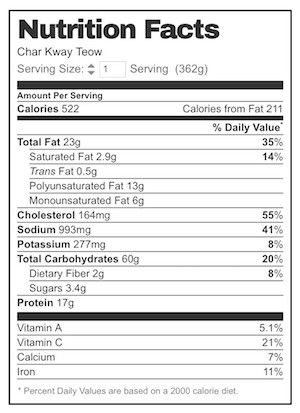
Nutrition Information:
LIFE OF DOZER
If dogs could talk: “Well come on. Give me a leg up, will ya?”

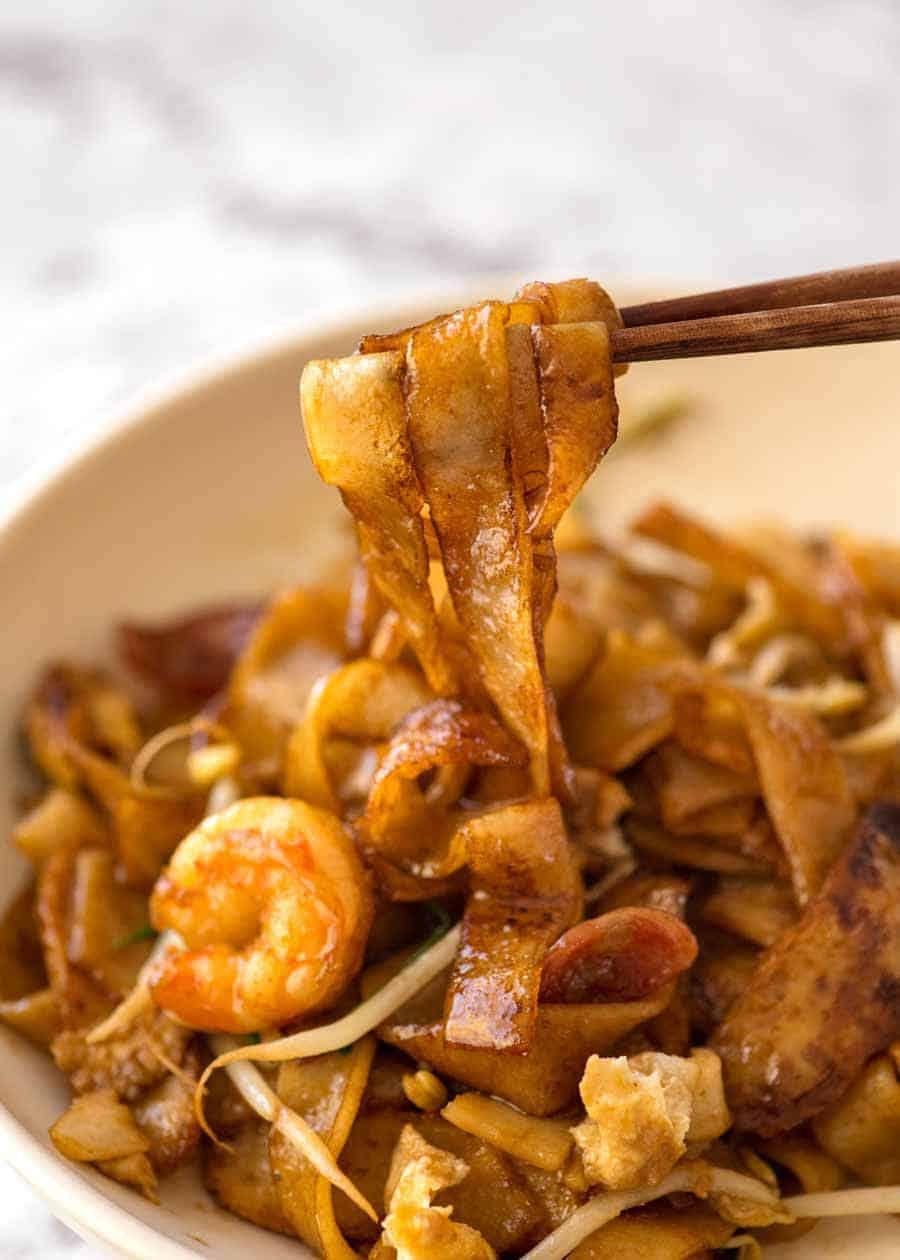
I can’t believe I just pulled off CKT!
As always, your instructions are so clear and easy to follow that I was emboldened to attempt the base method and it turned out great.
The only thing missing was that extra char flavour from a higher heat. 10/10 Nagi!
Wahoo!!! I’m so glad you loved it Diane!! N x
Really easy and delicious CKT recipe! I added chilies just for a bit more spiciness, definitely making this again. Thanks!
Pre oil the noodles in a bowl and they won’t stick. I also add half a teaspoon of sesame oil to the eggs as I whisk them.
I eat CKT whenever I go to China town this recipe was just as good the only difference is it doesn’t have the flavour of the wok because I just can’t get it hot enough, which is nothing to do with the recipe. I will be cooking this again and again!!
I’ve been using a blow torch to get that smokey flavour otherwise impossible on a domestic burner.
ooh that’s an interesting approach! so do you use the blow torch once it’s cooked and go over the noodles?
I blow torch the surface while noodles are in the wok after cooking, more or less like the instructions here.
https://www.nytimes.com/2020/09/04/dining/stir-fry-recipe-wok-hei.html
Partner says, “I’d be happy to have this again next week!” Thank-you Nagi and Dozer for another delicious meal and happy faces.
Absolutely the best recipe in the world! I’ve made this a million times and it never gets old. For anyone else looking: I find fresh rice noodles on the normal shelves in an asian supermarket with the rest of the noodles. The packet is really soft and has a short best before date because they are fresh. I also can only ever buy frozen sheets of fried fish cake. I don’t know how much 5cm would be, but I usually use 1-3 sheets.
I haven’t made this yet, but you are my HERO for posting this. Thank you!!
You’ll love it Christine!!! N x
Thanks so much for this great, easy CKT recipe! I followed the easier method and it turned out fantastic. Looking forward to making it for my Chinese Malaysian mum (who is an awesome cook, but never made CKT for us as kids. It was always something we ate out!).
Hi Nagi, If I want to add fish sauce to the recipe, do I have to decrease the amount of the other condiments? And I just want to thanks so much for sharing these recipes. Your recipes (along with being stuck at home the last couple of months) have changed me from someone who used to hate cooking to someone who’s always looking for recipes to make now. =)
Today’s my second attempt of your char kueh teow recipe. I like your recipe, it’s easy to prepare. It turned out that my family like the CKT I prepared. I notice if the prawns were a bit wet (from the fridge), it absorbed the oil and made it difficult to fried the kueh teow later. Since I prepared a kg of kueh teow in a not to big wok, it was quite challenging to manage.
Hi John, I’d just pat the prawns dry so you’re not getting excess water in the wok and the prawns stewing rather than frying. When making a big batch like this you’d need a large wok or cook in batches 🙂 N x
I’m sorry, but it ain’t CKT without cockles!
Brilliant recipe and easy to follow instructions, tastes very close to restaurant version. I skipped the lard but otherwise followed the recipe exactly, cooked for 4 servings in 2 batches. When I was measuring out the sauce it looked like a lot and I was afraid it would turn out too salty but it was perfect!
I’m so glad you stuck with it Rose! N x
Loved this. My only problem is I had to buy 1kg of fish cakes (I hope fried). What else can I do with them.
This one didn’t work for me, even the easier method. I bought fresh rice noodle sheets (Banh Pho Tuoi), and microwaved them as stated. Cut them into strips. Got to step 6 of the easy method and added them to the hot lard with the garlic. The noodles clumped together and congealed almost immediately. The dish turned into a sticky mess without any discernible noodles at all. What the heck went wrong? Was my wok too hot?
Hi Greg, I’m sorry to hear the recipe didn’t work out for you. I’m really not sure what would have caused them to clump. One suggestion I have is to rub the individual noodles lightly with oil using your hands when getting them ready. This might help them stay more separated. Otherwise, I would suggest trying another brand (if you can find one). Stir fried rice noodles are notoriously finnicky! Good luck – Nx
Super easy and super tasty!
I’m so glad you loved it Joanne! N x
This has got to be the best CKT recipe I’ve tried so far and it’s definitely a keeper!!
Hi Nagi, thank you for including Malaysia’s iconic CKT in your repertoire 👏🏻 I just had it for lunch **burp.
The original (best version) of ckt is w crispy little bombs of pork lard. Nowadays it is difficult to find due to health concerns and also, it is more convenient to sub w veg oil.
I’m so glad you loved it Mae!! Yes pork lard is amazing (just not for my waistline 😂)
I grew up eating CKT from my favourite hawker on Gurney Drive and consider myself somewhat of an expert. Your recipe is one of the best I have seen. The only element you are missing is the little crispy pork lardons.
Your tips are spot on in relation to the challenges and substitutions with this dish; the flexibility of the recipe and the method allows many restaurants to get close but you know it’s not quite right. Best CKT in Melbourne anyone???
I share your pain at not being able to source the freshly made rice noodles or replicate the fierce smokey wok hei. Setting up a charcoal burner in the backyard to make an authentic CKT is on my bucket list.
I’m a RAAF brat too, 76-78. Fell in love with this dish and found a little Malaysian shop in China town that did it perfect. But now I have the recipe and I have perfected it to my own taste. My mum cant believe I can make it. Thanks Nagi.
Great recipe! Just tried it using veggies and egg in place of the meat and it worked a treat. Thank you 🙂
Sounds great Anita!
This is on my “to make” list! In my pre-kids days hubs & i would enjoy going into melbs to Little Malaysia for this dish. I love that you’re Aussie add give info on where to get items and what Aussie products work etc. Love your recipes Nagi and this one looks divine! X
Thanks so much Corrine, I hope you give it a go, love to know what you think!